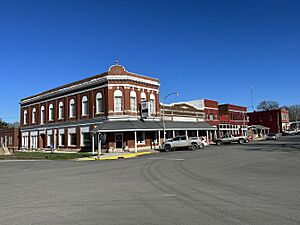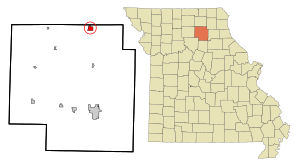La Plata, Missouri facts for kids
Quick facts for kids
La Plata, Missouri
|
|
|---|---|

Downtown La Plata
|
|

Location within Macon County and Missouri
|
|
| Country | United States |
| State | Missouri |
| County | Macon |
| Area | |
| • Total | 1.59 sq mi (4.13 km2) |
| • Land | 1.59 sq mi (4.11 km2) |
| • Water | 0.01 sq mi (0.02 km2) |
| Elevation | 938 ft (286 m) |
| Population
(2020)
|
|
| • Total | 1,257 |
| • Density | 791.56/sq mi (305.53/km2) |
| Time zone | UTC-6 (Central (CST)) |
| • Summer (DST) | UTC-5 (CDT) |
| ZIP code |
63549
|
| Area code | 660 |
| FIPS code | 29-40682 |
| GNIS feature ID | 2395569 |
La Plata is a small city in Macon County, Missouri, United States. In 2020, about 1,257 people lived there. La Plata is known for its train station, which offers passenger train service to big cities like Chicago and Los Angeles. The city is located near the border of Adair County. It also sits along a main railway line used by the BNSF Railway.
Contents
History of La Plata
Early Beginnings
The story of La Plata started on March 17, 1827. A man named Drury Davis set up a trading post near where the city is today. Over the next few years, his family and friends joined him. They created a small village. This village had a blacksmith shop, an inn, and a place for stagecoaches to stop.
How La Plata Got Its Name
The city of La Plata was officially planned in 1855. It was named after a city in Argentina, also called La Plata. The name "La Plata" comes from Spanish and means "silver." Two men, Louis Gex and Thomas Saunders, were important in planning the town. They drew straws to decide the name. Saunders wanted to name it "Charlottesville" after his sister. Gex wanted "La Plata." Gex won, and the town was first officially formed on September 29, 1856. W. W. Moore, another early settler, built the first hotel in La Plata.
Railroads and Growth
Trains played a big part in La Plata's growth. The North Missouri Railroad (later called the Wabash Railroad) arrived in 1867. Twenty years later, the Santa Fe Railroad also came through. It connected Chicago to Kansas City. Having two major railroads made La Plata a great place to ship goods. Things like timber, farm animals, and grains from northern Macon County and southern Adair County were sent from here.
Because of this growth, La Plata became a "fourth-class city" on April 4, 1881. Jacob Gilstrap was the first mayor. The city's first big factory was a creamery built in 1883. It could make over a ton of butter every day! Sadly, a fire destroyed it, and it was never rebuilt. Other small farming businesses, like chicken and turkey hatcheries, have also been in La Plata. Two large oil pipelines also run through the city. The first one, the Prairie Pipeline, came in 1912. For many years, there was a "tank farm" with huge storage tanks on the edge of the city.
The Wabash Railroad line through La Plata closed in 1991. However, the Amtrak train station is still open. It uses the Burlington Northern Santa Fe rail system. The Southwest Chief train still stops here. La Plata still has a small but active group of businesses today.
Schools in La Plata
The first school in La Plata was called "Long Branch." It opened in 1868, named after a nearby creek. In 1872, a new, bigger brick schoolhouse with five rooms was built. Today, children in La Plata and the nearby countryside go to schools in the La Plata R-2 school district.
Historic Places
Several buildings in La Plata are very old and important. They are listed on the National Register of Historic Places. These include the Lester and Norma Dent House, the John T. and Mary M. Doneghy House, the Gilbreath-McLorn House, and the La Plata Square Historic District.
Geography of La Plata
La Plata is located in the northeastern part of Macon County. Its northern edge is right on the county line. U.S. Route 63, a four-lane highway, runs along the east side of the city. This highway goes south about 20 miles to Macon, which is the main town of the county. It goes north about 13 miles to Kirksville in Adair County. Missouri Route 156 also goes through the south side of La Plata. It leads west about 10 miles to South Gifford and east about 15 miles to Novelty.
The city of La Plata covers about 1.59 square miles of land. Only a tiny bit, about 0.01 square miles, is water. La Plata is on high ground. Water from the west side of the city flows into Long Branch. This creek eventually joins the Little Chariton River and then the Missouri River. Water from the east side flows towards the Middle Fork of the Salt River, which then flows into the mighty Mississippi River.
Population Facts
| Historical population | |||
|---|---|---|---|
| Census | Pop. | %± | |
| 1870 | 546 | — | |
| 1880 | 529 | −3.1% | |
| 1890 | 1,169 | 121.0% | |
| 1900 | 1,345 | 15.1% | |
| 1910 | 1,605 | 19.3% | |
| 1920 | 1,463 | −8.8% | |
| 1930 | 1,406 | −3.9% | |
| 1940 | 1,421 | 1.1% | |
| 1950 | 1,331 | −6.3% | |
| 1960 | 1,365 | 2.6% | |
| 1970 | 1,377 | 0.9% | |
| 1980 | 1,423 | 3.3% | |
| 1990 | 1,401 | −1.5% | |
| 2000 | 1,486 | 6.1% | |
| 2010 | 1,366 | −8.1% | |
| 2020 | 1,257 | −8.0% | |
| U.S. Decennial Census | |||
In 2010, there were 1,366 people living in La Plata. There were 584 households, which are groups of people living together. About 28.8% of these households had children under 18. Many households were married couples living together. The average age of people in the city was about 42.1 years old. About 23.4% of the residents were under 18. A small but growing group of Amish people live in La Plata. Most of them work in farming.
Education
The public schools in La Plata are managed by the La Plata R-II School District. This district runs one elementary school and La Plata High School. La Plata also has a public library called the La Plata Public Library, where you can borrow books.
Famous People
- Lester Dent, a famous author who wrote the Doc Savage adventure books, was from La Plata.
See also
 In Spanish: La Plata (Misuri) para niños
In Spanish: La Plata (Misuri) para niños

